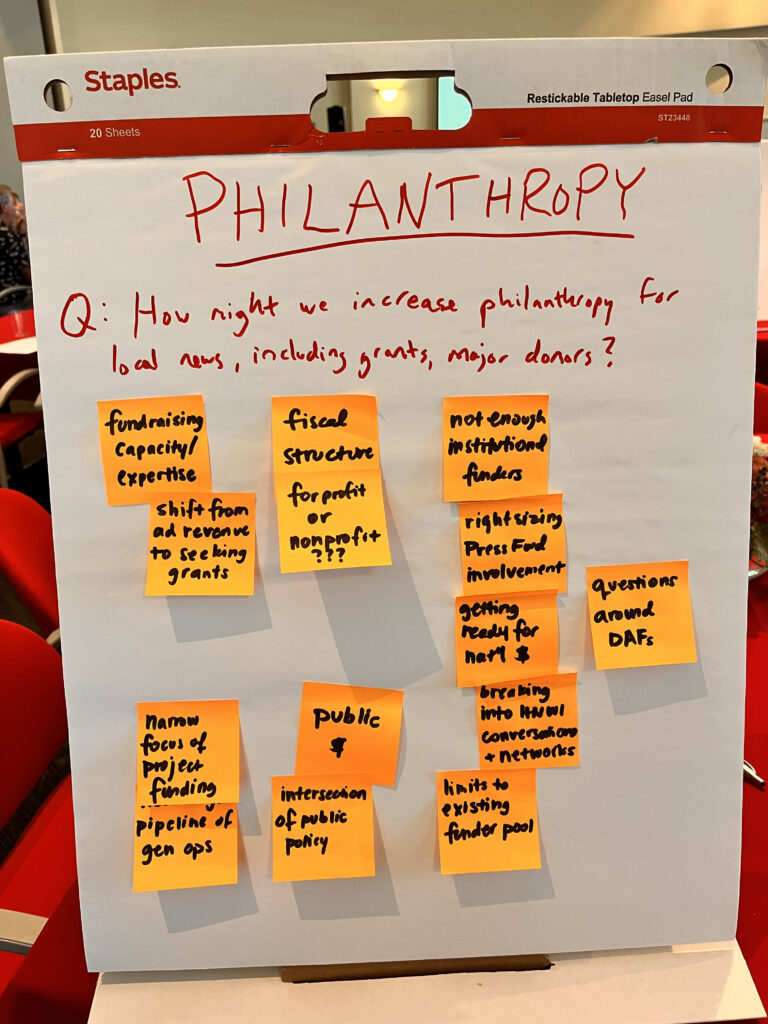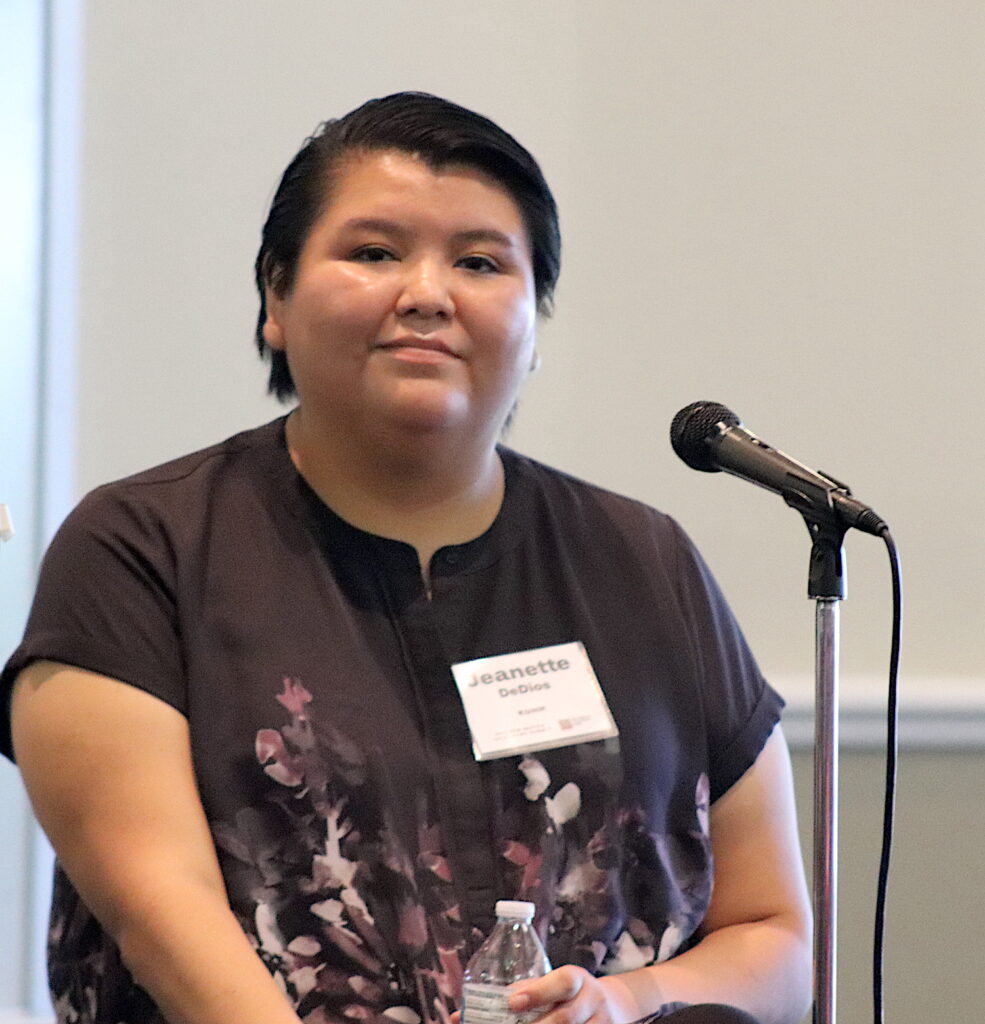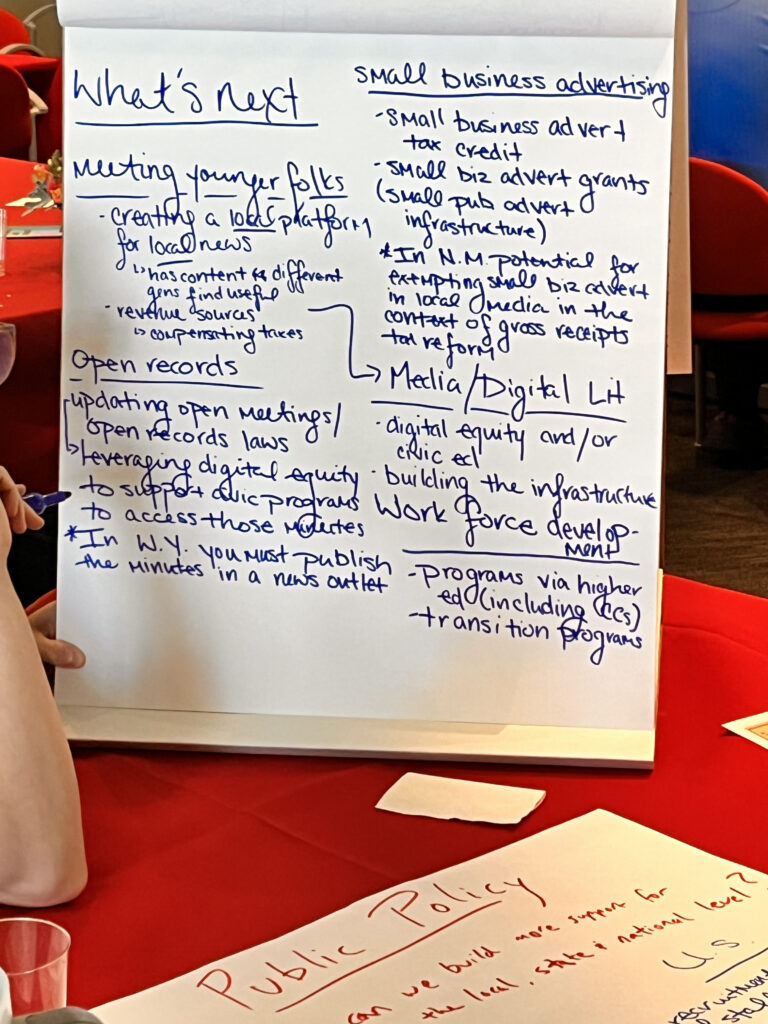First-ever NM journalism summit seeks solutions
By Joe Thompson, Allison Carpenter, Skye McMillon, Barbara Ramirez, and Alex Villalongja / NM News Port
New Mexico hosted a first-ever Local News Summit, on Sept. 30 in Albuquerque, drawing more than 100 people – including media owners, journalists, policy leaders, funding experts, and various community members – to sort through the wide range of challenges facing local-level journalism today, and to brainstorm ways to solve them.
The meeting was organized by The New Mexico Local News Fund.

(Photo by Joe Thompson / NM News Port)
“There’s a problem with not having enough quality information for communities in New Mexico,” said Mark Glaser, Director of Business and Program Development for the Local News Fund.
To open the meeting, Glaser recapped some of the challenges, which are not unique to New Mexico.
Newspapers are squeezed by high production costs at the same time their advertising revenue is vanishing into digital realms. On average, two newspapers close every week in the United States, laying off journalists and leaving communities uncovered. What fills the vacuum is social media which leads to misinformation, disinformation, and a decline in media trust.

In New Mexico, Glaser said, four counties have no newspaper at all, and 22 counties are down to only one – some of which don’t employ any local journalists.
While newspapers may be the most visible part of the local news crisis, the summit organizers emphasized the problem is bigger than that.
“We really tried to get a broad cross-section of media,” Mahmood said, “so that everyone can come together and have input and build a shared vision across all different types of media.”

Is philanthropy the future of journalism?
“One unassailable fact is that we’ve been in, essentially, a 25-year bear market when it comes to the local news ecosystem,” said Duc Luu, of the Knight Foundation, where he directs sustainability initiatives. The Knight Foundation is one of the largest journalism philanthropies and helped sponsor the summit.
Luu said newsrooms have been struggling to make ends meet despite set-back after set-back: the dot-com bust in 1999, the 2008 financial crisis, the rapid rise of big tech and social media, and, most recently, the pandemic — all dragging down efforts by newsrooms to grow and thrive.

Luu acknowledged that people are awash in information today, and that can obscure the problems in local journalism, but, he says, the actual loss of local journalism and the resulting weakening of civic life is a rising concern, and large funders are leading the way in seeding experiments and solutions.
One such funding push that got a great deal of attention at the Local News Summit is Press Forward, a $500-million initiative to support local news starting in 2024.
Luu added that this local summit is crucial in getting local funders to step up – because the next level of concern is how to bring local dollars into the mix.
(Credit: Santa Fe New Mexican)
In a panel discussion, the philanthropy model raised some questions about the independence of newsrooms.
“It’s not an employer-employee relationship,” said Allan Oliver, Executive Director of the Thornburg Foundation based in Santa Fe. “It is not a contractual relationship.” In other words, funders don’t dictate editorial content.
Tomasita Martínez Moriarty of the W.K. Kellogg Foundation said there’s certainly a power imbalance between funders and their recipients, but funders are sensitive to the needs of the community.
“We trust the community – and the news knows the community,” Martínez said.
National funding expert Amy Kovac-Ashley with the Lensfest Insitute for Journalism added that newsrooms need to be clear on their needs and their focus.
“I think journalists need to really think about who they are going to target for those philanthropy requests and what’s aligned from a mission standpoint,” she emphasized.
“There are a lot of things we don’t fund because they don’t fit our strategy,” Kovac-Ashley said.

(Photo by Barbara Ramirez / NM News Port)
One participant at the conference complained that small print publications have an uphill struggle. Journalist Diane Joy Schmidt is trying to revive The New Mexico Jewish Link, a print publication that went out of business last year.
“It seems like the focus is non-profit digital platforms,” Schmidt said. But her readership is older and print is the main way to reach them. She hopes to find a funding plan to revive the dead paper.
But reviving, or saving, is not exactly the pitch philanthropists want to hear, according to Duc Luu, with the Knight Foundation.
Saving… rescuing… are not really what we’re interested in.
Duc Luu, Knight Foundation
This is an investment.”
“As funders, hearing the words ‘saving,’ hearing the word ‘salvaging,’ ‘rescuing,’ is not really what we’re interested in,” Luu said. “This is an investment.”
But investors look for measurable returns, and that can be tricky for journalists, too.
Allan Oliver said journalists can’t always connect dollars spent on news to immediate results in the community. He suggests not fixating on ROI (Return on Investment) and similar metrics.
“Journalism is the key, the story,” Oliver said. “I have a boss who can look at ROI all day but you tell him a good story and he’s just like anybody else – he’s going to carry that story.”

Can newspapers survive in a changing industry?
The New Mexico Local News Summit featured a panel, “What’s the Future for the Newspaper Business?” to address the decline of physical newspaper sales, the rising competition of digital media, and how changing from print to digital is tricky and costly.
“The internet has changed news production, delivery, and storytelling in numerous ways,” said Algernon D’Ammassa, editor of The Deming Headlight, a paper that is experiencing financial difficulty.
“More and more people are reading news on a personal device, and it’s really just changed our relationship to the people that we’re serving,” D’Ammassa said.

(Photo by Alex Villalongja / NM News Port)
“What’s made our paper so special for so many years is that people can’t wait to get what they call the weekly gossip,” said Ryan Cangiolosi, an investor in El Rito Media LLC, which recently bought the Rio Grande Sun in Espańola. “They want to have it in their hands, and so I think that there is an element to that – that is so special.”
But, Cangiolosi said, the paper can’t ignore the trend toward digital.
“On the other side of it, we’re also smart enough to know that we’re going to have to start competing because it’s all about getting those stories out.”
“Digital requires a whole other skill set and a whole other person,” said the owner of Ctrl+P Publishing, Pat Davis, who prints papers in Albuquerque, Corrales, Edgewood, and Sandoval County. Davis is relatively new to newspaper ownership and says he is counting down the days when he will step down from elected office as an Albuquerque city council member.
Davis says high-quality digital publishing is increasingly costly.
“Good stuff like Newspack, Mailchimp, all of those things are fabulous tools, and we are all going to have them in order to do this – but they’re expensive,” said Davis. “It is becoming more and more of a financial burden to jump in.”
Fraser Nelson is the Chief Partnerships Officer for the National Trust for Local News. She brings a national perspective and is an advocate for the preservation of local newspapers.
“You can think of us as a land conservation movement but for newspapers,” Nelson said. “We acquire newspapers, conserve, transform, and sustain them.”
Nelson was instrumental in helping convert the Salt Lake Tribune from a corporate model to a nonprofit model. Her National Trust is now actively acquiring – and preserving – papers around the country.
“We are the fifth largest independent newspaper owner in the United States, and we are just getting started,” Nelson said.
In break-out groups, attendees talked about the age factor – noting that older individuals tend to read physical print, while younger generations gather information from digital platforms – making it hard to serve both demographics. Moreover, not all communities have ready access to broadband internet, so digitizing news could isolate them further.
Another concern was how the cost of living in certain areas of the U.S. can contribute or detract from a news outlet’s lifespan.

(Photo by Mark Glaser / NM Local News Fund)
New Mexico’s underserved communities suffer outsized effects of the local news crisis.
At the summit, journalists and community members discussed the inequities experienced by underserved communities in New Mexico.
Geographically, New Mexico is a very rural state. Only seven of its 33 counties contain predominantly urban areas, according to the U.S. Census.
In the session, “How to Meet the Information Needs of Underserved Communities,” participants pointed out that many rural New Mexico communities don’t have broadband access and may have no local news source.
Participants said underserved communities include people whose first language is not English, but also black residents, indigenous peoples, other people of color, rural residents, and homeless people.

“We feel very strongly that there is not such a thing as the voiceless,” said Roberta Rael, Executive Director of Generation Justice, a youth media organization. “Whether it is the unhoused, the children, the elders, or whoever is out there. It is not that they are voiceless, it’s that no one has given them the mic.”
Representation in the newsroom is essential to fully serving under-represented communities, said Shirley Sneve, an executive with Indian Country Today.
“We developed partnerships with mainstream news sources, so when they have ‘the Indian question,’ there is someone in their newsroom who has the facts,” Sneve said.
It is not that they are voiceless, it’s that no one has given them the mic.
– Roberta Rael, Generation Justice
“Try to get to know the community that you are in, while you are in it,” was the advice of Hal David Roberts, a communications leader with the New Mexico Black Leadership Council. Roberts produces a local newsletter for Albuquerque’s International District.
“Don’t get to know it just from the newsroom or just what you hear,” Roberts said, urging journalists to go and get to know the community they are serving.

(Photo by Joe Thompson / NM News Port)
How can the government help support local news?
“Public policy is not a silver bullet – there’s not one public policy that’s going to save us,” said Anna Brugman, director of policy at Rebuild Local News, a national organization that helps produce policy solutions for journalism.
“I could pass every public policy in our portfolio and we would still have problems,” Brugman said, speaking to what attendees called the “all of the above” approach to advancing journalism today.
Still, Brugman brought a lot of ideas to the New Mexico Local News Summit. For example, at the national level there’s a bill called the Journalism Competition and Preservation Act, which is an antitrust policy that would give publishers the ability to band together to negotiate for remuneration from Google and Facebook, the tech giants that control the vast majority of digital advertising dollars in America.

The panel included moderator Lily Irvin-Vitela, left, State Representative Joy Garratt, and Anna Brugman of Rebuild Local News, right.
(Photo by Skye McMillon / NM News Port)
Meanwhile, Brugman said, a bill in congress dubbed “The Community News and Small Business Support Act,” which provides a tax credit for local businesses that advertise in local media, and a payroll tax credit to bring direct relief to local news organizations that have employees.
She even cited some policy ideas that could play out at the city level, such as subsidizing local advertising or providing a gross receipts tax refund.
In a panel session on policy possibilities, moderator Lily Irvin-Vitela, a communications consultant, recalled a series of community conversations on behalf of local journalism in New Mexico, where she heard how vital local news is for small communities.
“We all had a lot in common,” she said, “and one of the messages that came through loud and clear from folks who are already highly engaged in community is that they believe in their local media – they trust their local media – but not when the coverage isn’t coming locally.”

(Photo by Barbara Ramirez / NM News Port)
Summit organizer Mark Glaser said the state of New Mexico is investing in local news through its support of a Local News Fellowship program run by The Local News Fund and UNM Communication and Journalism Department. Glaser said the local news fund will be pursuing $500,000 from the state legislature for the local news fellows next year.
Similar programs are being funded by state governments in California and Washington.
One of the New Mexico Local News Fellows, UNM graduate Jeanette DeDios, appeared on the policy panel and vouched for the value of public investment in workforce training. It takes financial pressure off of employers and increases the prospect of keeping young talent in the field of journalism, and hopefully remaining in New Mexico.

(Photo by Barbara Ramirez / NM News Port)
“We need to show the community that they are important and they are worth covering,” DeDios said.
Where to go from here
“This was the first time we did this. It was very successful,” Glaser said. “We got a lot of sponsors. We sold out all of the tickets, and we had a lot of reporters and students coming.”
“So far from the response, I think there’s a good chance we’ll do more,” Glaser added.
Meantime, Glaser is in the process of gathering all the notes from the conference so that the ideas and solutions are preserved and shared for further consideration.

He also said that New Mexico is looking at ways to fundraise on a wide, local level, so it might present a matching-grant opportunity in the national Press Forward campaign that rolls out next year.
“I hope the thing that people take away is that they’ll understand the issues — and that they’re all a part of that solution,” Glaser said.
“They all have a voice in how we can make things work so that people get the news that they need.”